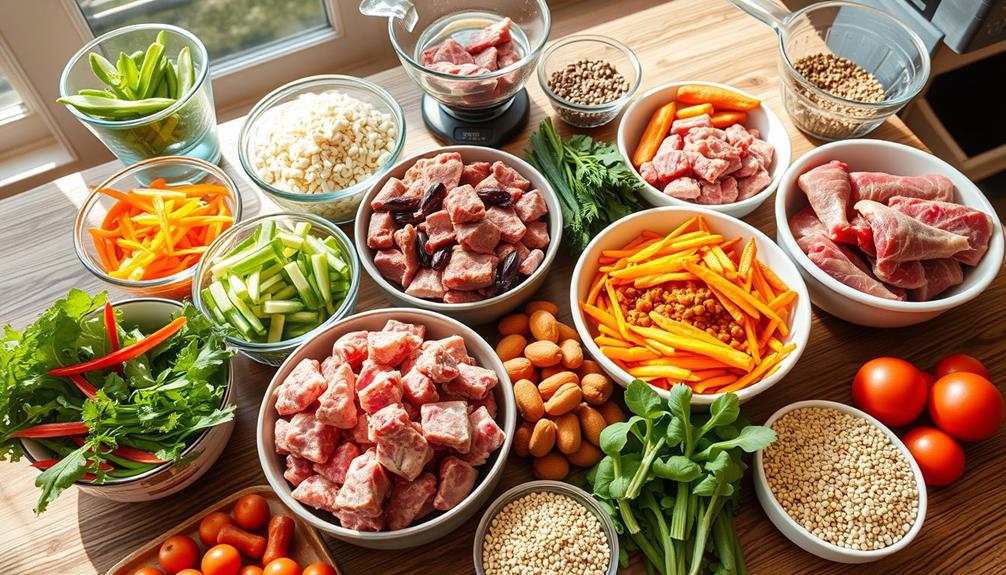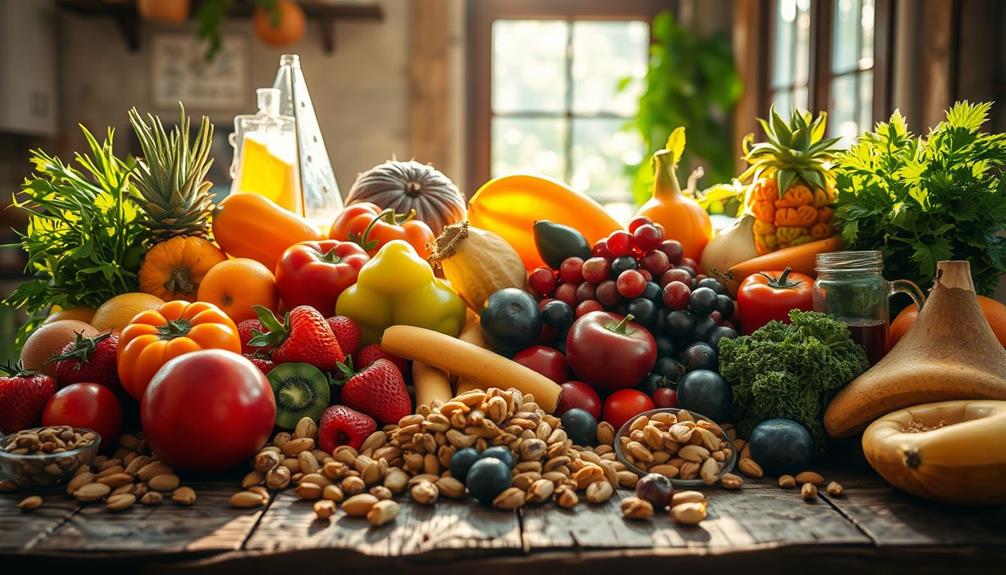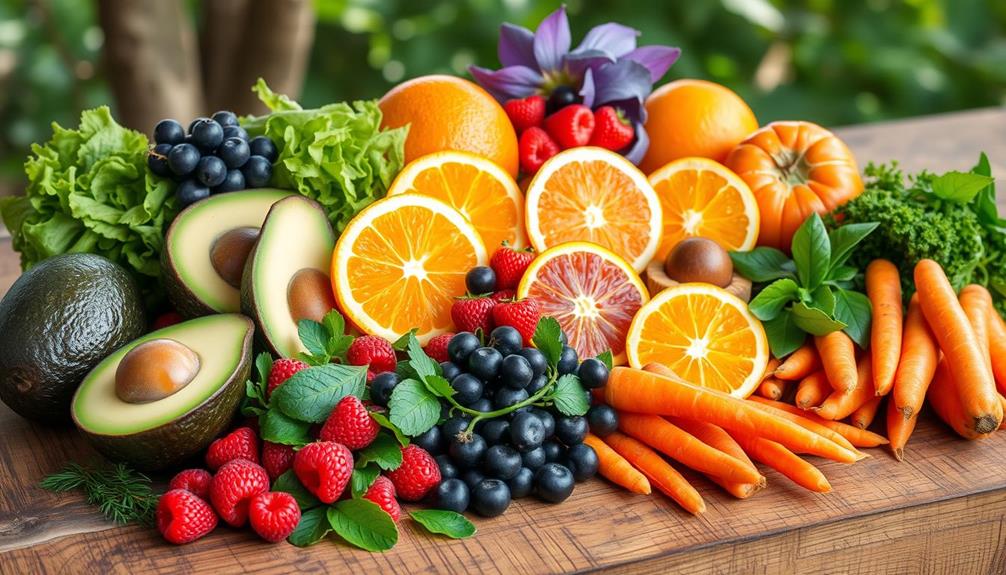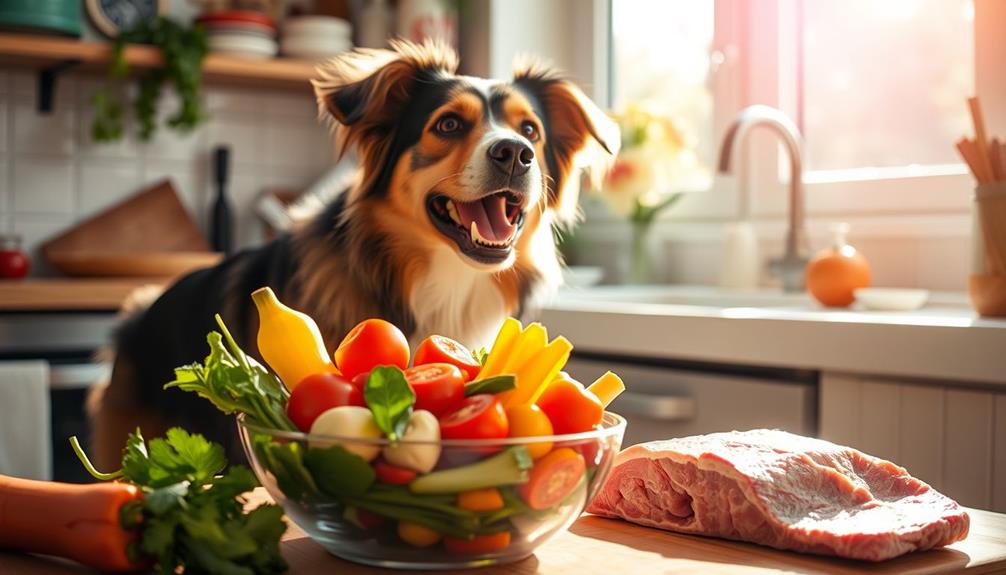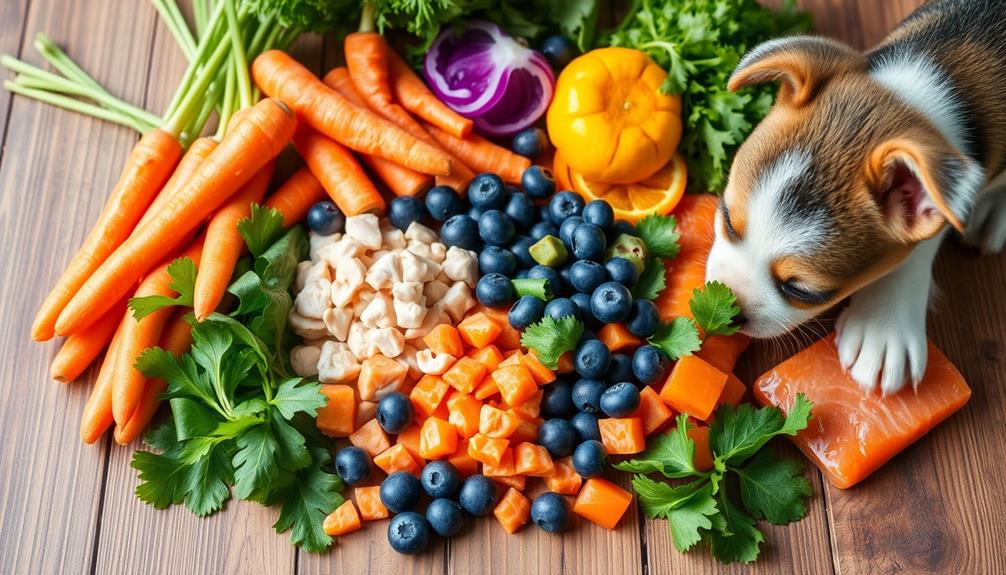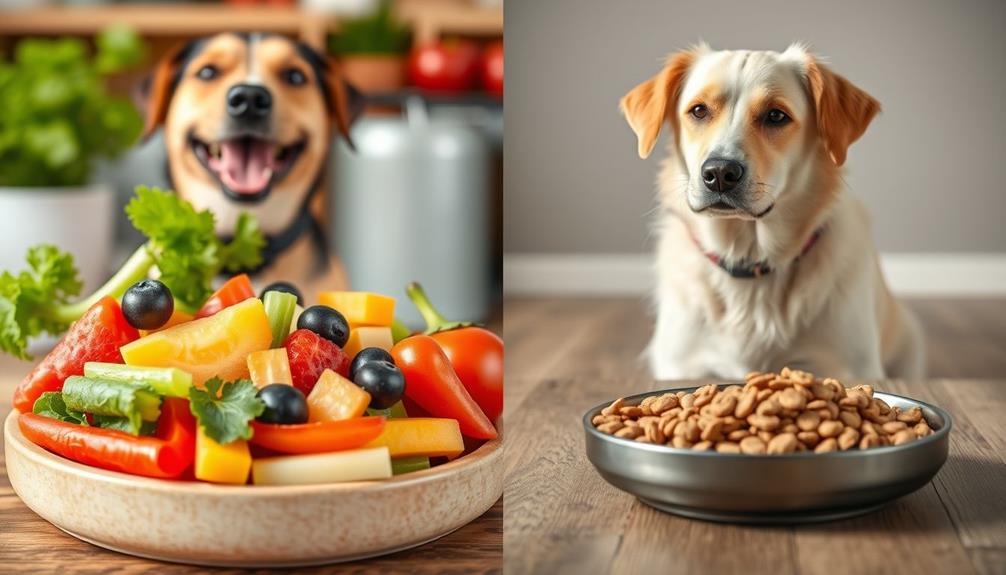When feeding your dog raw food, aim for 2-3% of their body weight daily for adults and 5% for puppies, split into 2-3 meals. Monitor your dog's weight and adjust portions based on their activity levels and body condition; ribs should feel like the back of your hand for a healthy weight. Gradually shift to raw food over 7-10 days to prevent digestive issues, and keep an eye on their energy and stool consistency. For a balanced diet, follow the BARF model, which emphasizes muscle meat and essential nutrients. There's plenty more to explore when it comes to raw feeding guidelines!
Key Takeaways
- Puppies need at least 5% of their body weight in raw food daily, divided into 2-3 meals.
- Adult dogs should consume 2-3% of their body weight, adjusting for activity level and metabolism.
- Gradually transition to raw food over 7-10 days to prevent digestive issues.
- Follow the BARF model: 70% muscle meat, 10% raw bones, 7% vegetables, and 10% organs for balanced nutrition.
- Monitor your dog's body condition regularly to adjust food portions and prevent obesity or malnutrition.
Puppy Nutrition Needs
When it comes to your puppy's nutrition needs, getting the right raw food portions is vital for their rapid growth and development. Puppies typically require at least 5% of their body weight in raw food each day, divided into multiple meals.
It's also important to guarantee your puppy is receiving proper diet guidelines that include a balance of proteins, fats, and carbohydrates. This feeding guide helps guarantee they receive the necessary nutrients for their active lifestyle.
For large breed dogs, especially those over 70 lbs, it's essential to provide raw food that meets their specific nutritional requirements. This helps promote healthy growth and prevent potential developmental issues.
Puppylicious offers a complete and balanced raw puppy food formulated to adhere to the AAFCO Nutrient Profile for Growth and Development, providing a reliable option for your growing pup.
If you're considering shifting to raw food, do it gradually to avoid digestive upset. Start by mixing small amounts of raw food with their current diet and carefully monitor how your puppy responds.
Resources are available to assist you with feeding strategies, shifting tips, and FAQs about puppy nutrition needs. By following these guidelines, you can guarantee your puppy gets the best start in life with a healthy raw food diet.
Adult Dog Feeding Guidelines
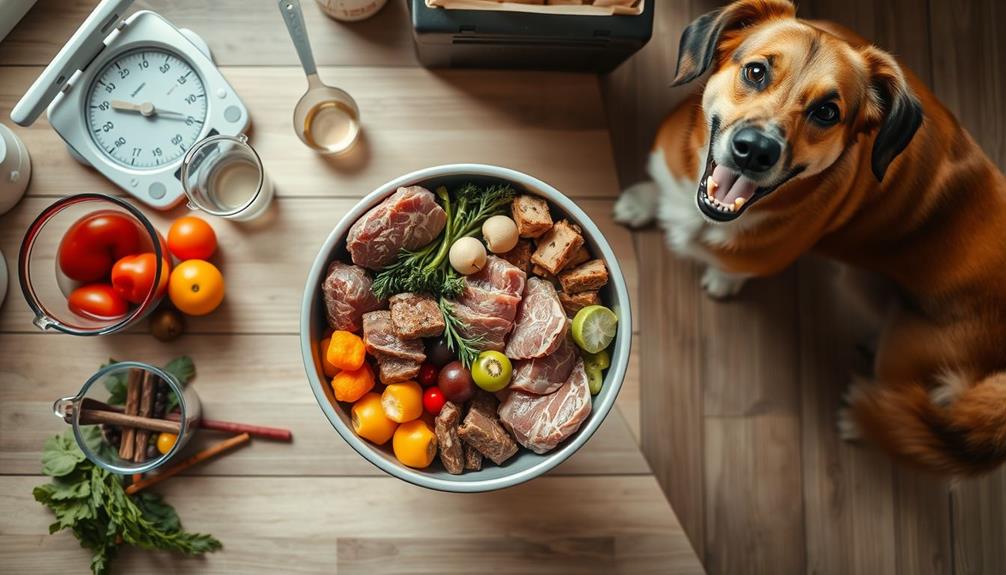
Feeding your adult dog the right amount of raw food is essential for maintaining their health and energy levels. Incorporating healthy dog snacks into their diet can further enhance their overall wellness and keep them engaged.
To determine the proper amount, consider these feeding guidelines based on your dog's body weight and activity level:
- Daily Intake: Adult dogs should be fed 2-3% of their body weight daily. For example, a 50-pound dog needs about 1 to 1.5 pounds of raw food.
- Meal Frequency: Split the total daily amount into 1-2 meals. More active dogs may require closer to 3%, while less active or overweight dogs should aim for around 1.5%.
- Adjust Portions: Tailor portion sizes based on individual factors, including metabolism and activity level. Regularly monitor your dog's body condition and adjust food intake as necessary to prevent obesity.
Determining Ideal Weight
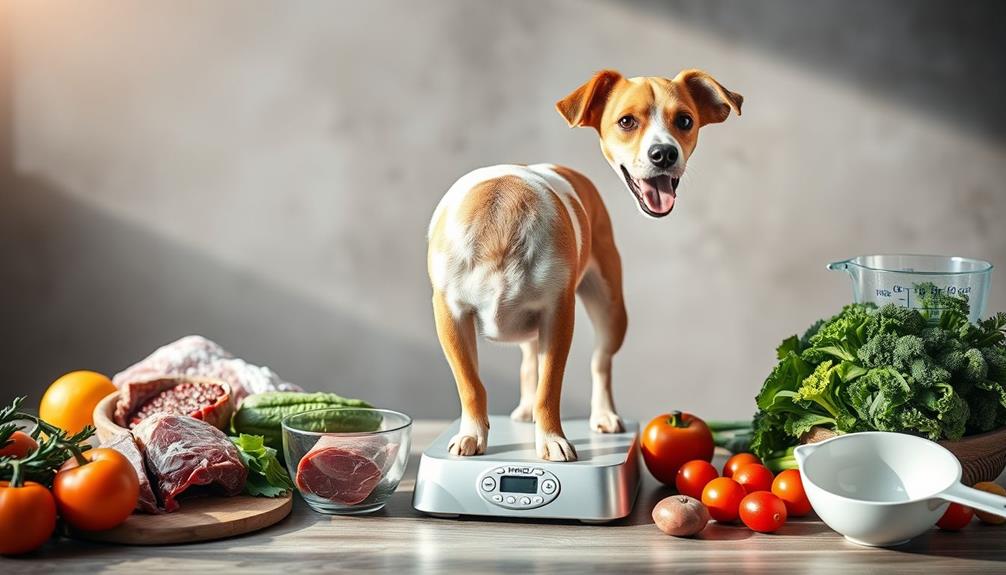
When figuring out your dog's ideal weight, don't rely solely on what you see; use your hands to assess their body condition.
Ideally, their ribs should have a feel similar to the back of your hand, indicating a healthy weight. If they feel more like your knuckles or the area between your palm and thumb, it's time to adjust their food intake accordingly.
Additionally, consulting with a veterinarian can provide valuable insights into your dog's nutritional needs and guarantee their overall health and well-being, especially as they age and may require different dietary considerations like financial planning for elderly care.
Visual Weight Assessment Techniques
Determining your dog's ideal weight can be tricky, especially if you rely solely on visual assessments.
While you might think you can gauge their weight just by looking, it's vital to combine this with tactile evaluations for a more accurate assessment.
Additionally, being aware of your dog's nutritional needs and any health conditions can influence their ideal weight and feeding guidelines.
Here are three techniques to help you determine your dog's ideal weight:
- Feel their ribs: When you run your hands along your dog's sides, their ribs should feel like the back of your hand. This indicates a healthy body condition and is important for managing their overall health, similar to the way cold medications impact health.
- Assess body shape: Look for a defined waist when viewed from above. If you can't see this waist, your pup may be overweight and require adjustments to their raw food intake.
- Check for knuckles: If your dog's ribs feel like knuckles, they may be underweight. In this case, consider increasing their food intake to meet their body weight daily.
Ideal Weight Indicators
Understanding your dog's ideal weight is vital for their health and well-being. To accurately determine your dog's weight, rely on physical touch rather than just visual assessments. You want to feel your dog's ribs—they should be like the back of your hand, indicating a healthy body condition.
If their ribs feel similar to the area between your palm and thumb, your dog may be overweight and could need dietary adjustments. On the other hand, if their ribs feel like knuckles, it suggests they're underweight, meaning you should consider increasing the amount of food you provide.
Maintaining a stable self-image is important for overall health, much like how understanding your dog's weight contributes to their well-being, as emotional dysregulation can affect various aspects of life.
Regular monitoring of your dog's physique and weight is essential for maintaining their overall health. Keeping an eye on these ideal weight indicators helps prevent health issues like obesity or malnutrition.
Physical Touch Evaluation
Knowing how to evaluate your dog's body condition through physical touch can greatly enhance your ability to maintain their ideal weight. This hands-on approach is more reliable than just visual assessments, similar to how understanding key domains of development is vital in child psychology.
Here's how to determine if your dog is at an ideal weight:
- Feel the Ribs: Your dog's ribs should feel like the back of your hand. This indicates a healthy level of fat covering.
- Check for Overweight Signs: If the ribs feel like the area between your palm and thumb, your dog may be overweight and need to shed some pounds.
- Assess for Underweight Indicators: Conversely, if the ribs feel like your knuckles, your dog is likely underweight and might require increased food intake.
Regularly checking your dog's body condition through physical touch is essential for their overall health. It helps you spot potential issues early, preventing obesity-related problems down the road.
Raw Food Transition Tips
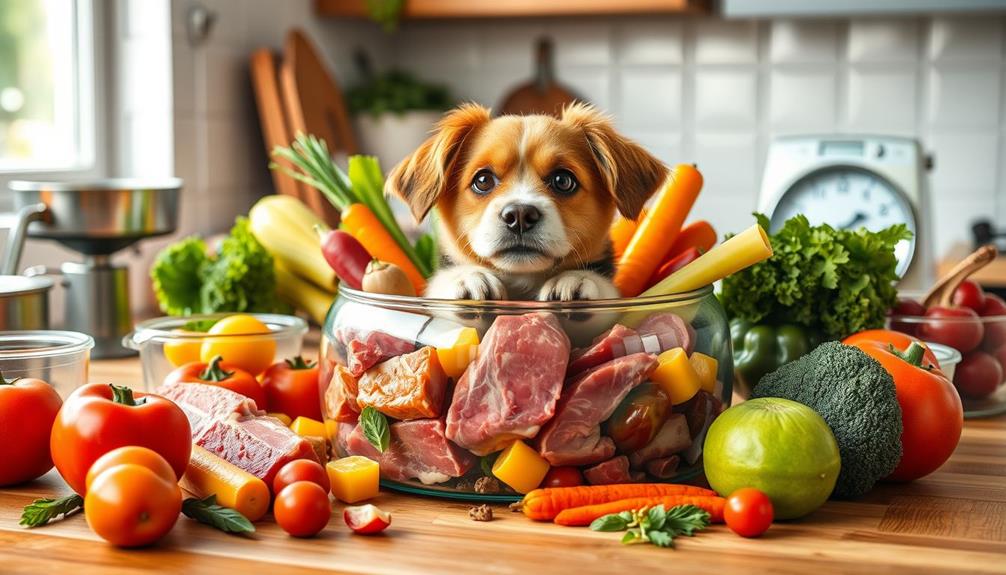
When you're shifting your dog to raw food, it's vital to do it gradually over 7-10 days to prevent any digestive issues.
During this period, it's important to observe how the raw food diet supports digestive health and keep an eye on your dog's energy levels and stool consistency to guarantee they're adjusting well.
Don't hesitate to consult your veterinarian for tailored advice and to address any concerns that may arise.
Gradual Transition Process
Adjusting your dog to a raw food diet can be a rewarding journey that requires patience and attention. To guarantee a smooth changeover, follow these essential tips:
1. Start Slow: Introduce raw food gradually over a week. Begin with a small portion mixed with their current food and slowly increase the raw food ratio. This helps minimize digestive issues.
Additionally, as with any new food introduction, monitoring for any signs of discomfort is vital, similar to how proper aftercare is essential for healing signs of infection.
2. Monitor Closely: Keep an eye on your dog's response during the changeover. Look for signs of discomfort or digestive issues, and adjust the pace if needed.
If your dog has a sensitive stomach or pre-existing issues, consider extending the transition period to several weeks.
3. Consult Your Vet: Always check with your veterinarian for personalized advice tailored to your dog's health needs.
They can help you formulate a balanced diet that meets all nutritional requirements.
Monitor Digestive Health
Monitoring your dog's digestive health during the change to a raw food diet is vital for ensuring a successful adaptation. Start by gradually introducing raw food over 7 to 10 days to minimize any risk of digestive upset. Keep an eye on your dog's stool consistency and frequency; a firm, well-formed stool is a key indicator of a smooth change.
Here's a quick guide to help you monitor your dog's progress:
| Observation | Action |
|---|---|
| Firm stool | Continue with the current raw food ratio |
| Loose stool/diarrhea | Reduce raw food and increase previous food |
| Low energy levels | Assess food proportions and consult vet advice |
If you notice any digestive issues like diarrhea or vomiting, it's important to slow down the change process. Also, watch your dog's energy levels and overall behavior, as any changes may signal discomfort. By attentively monitoring these aspects, you can address any issues promptly, ensuring a healthier and happier change to raw feeding.
Consult Veterinary Advice
Changing to a raw food diet can be a significant change for your dog, and seeking veterinary advice is essential for a smooth process. Consulting with a veterinarian helps you understand your dog's specific health needs and provides personalized guidance.
Additionally, it's important to take into account the overall health of your pet, as maintaining kidney health can play an important role in their diet shift.
Here are three critical reasons to involve your vet in the shift:
- Customized Shift Plan: Your vet can recommend a gradual introduction of raw food to minimize digestive upset, often suggesting you mix raw food with kibble or shift over several days to weeks.
- Monitoring Health: During the shift, your vet can assist in monitoring your dog's response, including energy levels and stool consistency, ensuring the new diet meets their health needs.
- Identifying Health Issues: Your veterinarian can help identify any underlying health issues that may complicate the shift, ensuring a safe and effective change to a raw food diet.
Utilizing the resources your vet provides, along with detailed shift strategies, will enhance your success in this journey.
BARF Model Ratio Guidelines
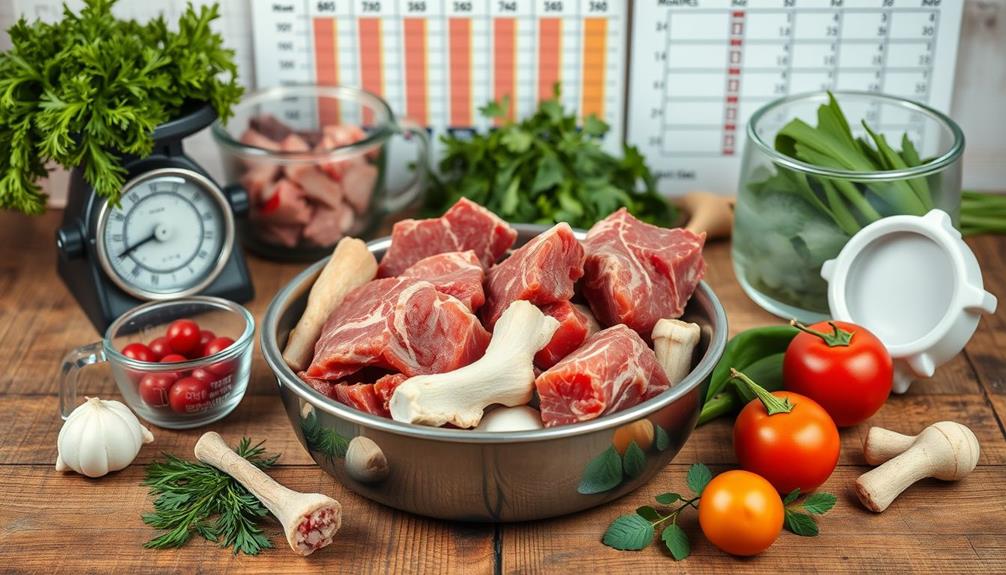
When it comes to crafting a balanced diet for your dog using the BARF model, understanding the recommended ratios is fundamental. The BARF diet focuses on providing ideal nutrition through specific amounts of raw food.
You'll want to guarantee that 70% of your dog's daily intake consists of muscle meat, as this is crucial for delivering protein, amino acids, and significant water-soluble vitamins. Additionally, consider incorporating essential oils like eucalyptus oil for its decongestant properties, which can enhance overall health and well-being.
Next, include 10% raw edible bones, which are key for calcium and phosphorus—important for strong bones and firm stools.
Don't forget about vegetables, making up 7% of the diet. Preparing them through pureeing or steaming enhances digestibility and offers necessary carbohydrates and fiber.
Incorporate 5% liver and 5% other secreting organs into the mix, as they supply essential fat-soluble vitamins and additional nutrients that contribute to the overall balance of the BARF diet.
Nutritional Benefits of Raw Feeding
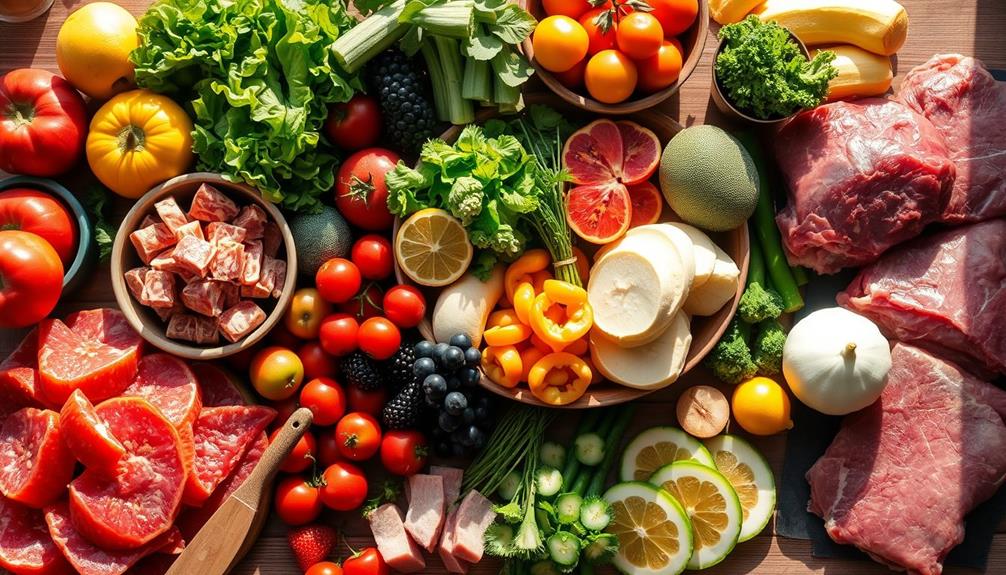
Raw feeding offers a range of nutritional benefits that can revolutionize your dog's health and well-being. By providing a diet rich in unprocessed meats, organ meats, and safe fruits and vegetables, you'll be meeting your dog's dietary needs while enhancing their overall health.
The benefits of raw are significant and include:
- Healthier Skin and Coat: Raw food is packed with essential nutrients that promote a shiny coat and improve skin conditions, reducing issues like dryness and irritation.
- Smaller, Firmer Stools: Dogs on a raw diet tend to produce smaller and firmer stools, indicating better digestion and nutrient absorption compared to processed kibble.
- Fewer Health Issues: Research shows that raw feeding can lead to a decrease in obesity, arthritis, and allergies, contributing to a longer lifespan for your furry friend.
Incorporating the BARF model guarantees you maintain a balanced approach, with muscle meat, raw edible bones, and vegetables to keep the nutrients your dog needs.
With proper safety protocols in place, shifting to raw food can be a rewarding choice for both you and your beloved dog.
Tools for Raw Feeding
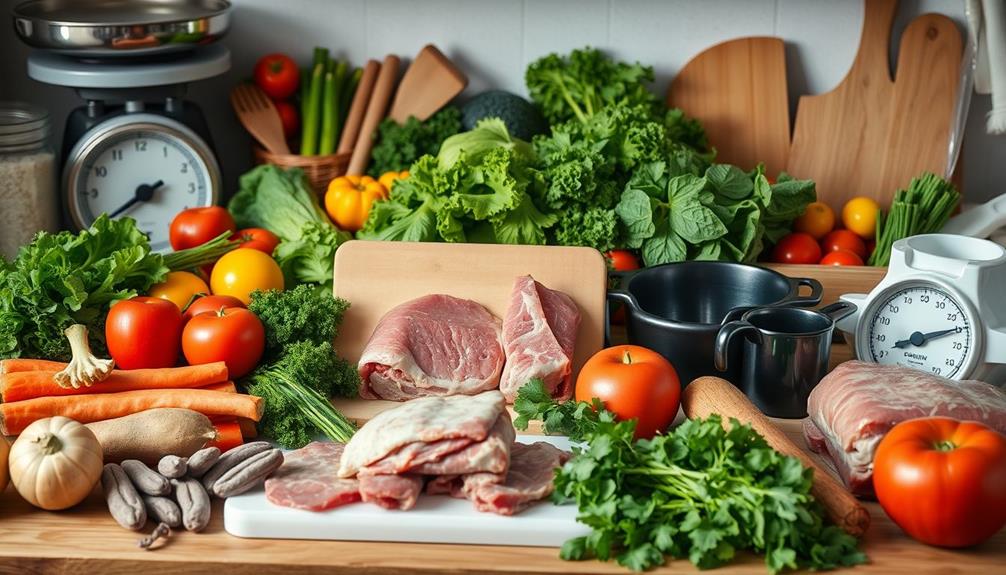
Feeding your dog a raw diet can seem intimidating at first, but with the right tools, it becomes much more manageable. One essential tool is a raw dog food calculator, which helps determine how much raw food to feed based on your dog's weight, age, and activity level. This guarantees your dog receives the essential nutrients they need to thrive.
Here's a quick reference table to guide you:
| Dog Type | Daily Feeding Percentage | Recommended Meal Frequency |
|---|---|---|
| Adult Dogs | 2-3% of body weight | 2 meals |
| Puppies | 5% of body weight | 2-3 meals |
| Active Dogs | Adjust higher | 2 meals |
| Small Dogs | 2-3% of body weight | 2 meals |
| Large Dogs | 2-3% of body weight | 2 meals |
Keeping track of your dog's weight is vital. Adjust raw food portions as needed to maintain a healthy weight. Understanding preferred food formats, like patties or medallions, can simplify feeding and make it more efficient for you and your dog.
Frequently Asked Questions
What Is the 80 10 10 Rule for Raw Dog Food?
The 80 10 10 rule for raw dog food means you'll feed your dog 80% muscle meat, 10% raw edible bone, and 10% organ meat. This balanced approach guarantees ideal nutrition and health for your furry friend.
How Much Raw Food Should I Feed My Dog Chart?
So you think your dog's a gourmet? Well, grab a calculator! Use their weight and activity level to figure out how much raw food they need. It's not rocket science—just basic dog math!
How Much Raw Food Should I Feed My?
When deciding how much raw food to feed your dog, consider their weight, activity level, and age. Generally, aim for 2-3% of their body weight daily, adjusting portions based on their energy needs. It’s important to consult with a veterinarian before transitioning your dog to a raw food diet, as not all canines can tolerate this type of feeding. If they do well with the switch, though, a raw food diet can provide a variety of health benefits such as shinier coats, increased energy, and improved digestion. With proper portion control and monitoring, a raw food diet can be a healthy and balanced option for your furry friend. When considering the affordability of a raw food diet for your dog, it’s important to factor in the raw food cost calculation. While it may seem more expensive upfront, over time, the potential savings on vet bills due to improved health and reduced need for certain medications can outweigh the initial investment. Additionally, sourcing raw food in bulk or looking for local suppliers can help minimize costs. Tracking your dog’s health and behavior through regular check-ins with the vet can also help determine if the raw food diet is a cost-effective and beneficial option for your pet.
What Are the Guidelines for Raw Food Dogs?
Feeding your dog raw food's like hosting a gourmet feast every day! Stick to guidelines: 2-3% of their body weight, adjust for activity, and monitor health. Remember, every pup's unique, so stay attentive!
Conclusion
In summary, feeding your furry friend a raw diet can be a rewarding route to robust health. Remember, balance is key—be mindful of meat, minerals, and more to guarantee a nourishing bowl. As you navigate this new nutrition, keep an eye on their energy, enthusiasm, and overall well-being. With patience and practice, you'll pave the path to a happy, healthy pup. So, embrace the benefits of raw, and watch your dog thrive!

